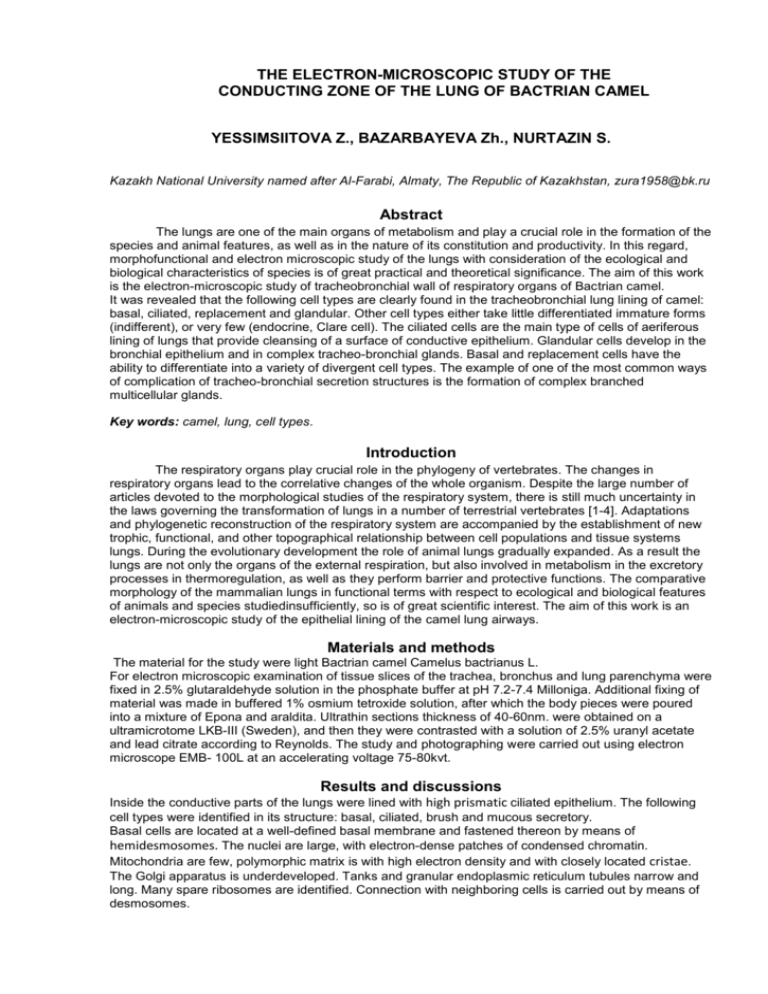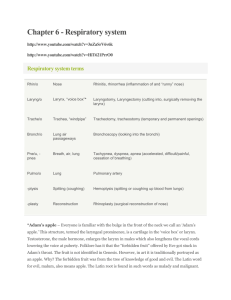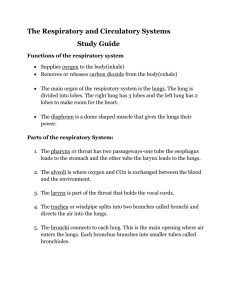THE ELECTRON-MICROSCOPIC STUDY OF THE CONDUCTING
advertisement

THE ELECTRON-MICROSCOPIC STUDY OF THE CONDUCTING ZONE OF THE LUNG OF BACTRIAN CAMEL YESSIMSIITOVA Z., BAZARBAYEVA Zh., NURTAZIN S. Kazakh National University named after Al-Farabi, Almaty, The Republic of Kazakhstan, zura1958@bk.ru Abstract The lungs are one of the main organs of metabolism and play a crucial role in the formation of the species and animal features, as well as in the nature of its constitution and productivity. In this regard, morphofunctional and electron microscopic study of the lungs with consideration of the ecological and biological characteristics of species is of great practical and theoretical significance. The aim of this work is the electron-microscopic study of tracheobronchial wall of respiratory organs of Bactrian camel. It was revealed that the following cell types are clearly found in the tracheobronchial lung lining of camel: basal, ciliated, replacement and glandular. Other cell types either take little differentiated immature forms (indifferent), or very few (endocrine, Clare cell). The ciliated cells are the main type of cells of aeriferous lining of lungs that provide cleansing of a surface of conductive epithelium. Glandular cells develop in the bronchial epithelium and in complex tracheo-bronchial glands. Basal and replacement cells have the ability to differentiate into a variety of divergent cell types. The example of one of the most common ways of complication of tracheo-bronchial secretion structures is the formation of complex branched multicellular glands. Key words: camel, lung, cell types. Introduction The respiratory organs play crucial role in the phylogeny of vertebrates. The changes in respiratory organs lead to the correlative changes of the whole organism. Despite the large number of articles devoted to the morphological studies of the respiratory system, there is still much uncertainty in the laws governing the transformation of lungs in a number of terrestrial vertebrates [1-4]. Adaptations and phylogenetic reconstruction of the respiratory system are accompanied by the establishment of new trophic, functional, and other topographical relationship between cell populations and tissue systems lungs. During the evolutionary development the role of animal lungs gradually expanded. As a result the lungs are not only the organs of the external respiration, but also involved in metabolism in the excretory processes in thermoregulation, as well as they perform barrier and protective functions. The comparative morphology of the mammalian lungs in functional terms with respect to ecological and biological features of animals and species studiedinsufficiently, so is of great scientific interest. The aim of this work is an electron-microscopic study of the epithelial lining of the camel lung airways. Materials and methods The material for the study were light Bactrian camel Camelus bactrianus L. For electron microscopic examination of tissue slices of the trachea, bronchus and lung parenchyma were fixed in 2.5% glutaraldehyde solution in the phosphate buffer at pH 7.2-7.4 Milloniga. Additional fixing of material was made in buffered 1% osmium tetroxide solution, after which the body pieces were poured into a mixture of Epona and araldita. Ultrathin sections thickness of 40-60nm. were obtained on a ultramicrotome LKB-III (Sweden), and then they were contrasted with a solution of 2.5% uranyl acetate and lead citrate according to Reynolds. The study and photographing were carried out using electron microscope EMB- 100L at an accelerating voltage 75-80kvt. Results and discussions Inside the conductive parts of the lungs were lined with high prismatic ciliated epithelium. The following cell types were identified in its structure: basal, ciliated, brush and mucous secretory. Basal cells are located at a well-defined basal membrane and fastened thereon by means of hemidesmosomes. The nuclei are large, with electron-dense patches of condensed chromatin. Mitochondria are few, polymorphic matrix is with high electron density and with closely located cristae. The Golgi apparatus is underdeveloped. Tanks and granular endoplasmic reticulum tubules narrow and long. Many spare ribosomes are identified. Connection with neighboring cells is carried out by means of desmosomes. Ciliated cells have cytoplasm average electron density. In the apical section numerous mitochondria with coated matrix and quite rare Kristen can be identified. Granular endoplasmic reticulum is short, narrow, sometimes slightly dilated tanks bearing membrane-associated single ribosome. Free ribosomes quite a lot. On the apical surface numerous cilia can be seen (Figure 1a). 1 1 2 a b Figure 1: a) ciliated cell.1- cilia, cut crosswise; 2-ciliated cell cytoplasm; b) glandular cells. 1- secretory granules in the apical part of the cell. Replacing cells are much less common than the ciliate. This type of cells characterized by cytoplasm with high electron density, have numerous mitochondria and rough endoplasmic reticulum tank. On the apical surface numerous microvilli are found. Occasionally smaller homogeneous secretory granules of serous or mucoid character can be found in the cytoplasm of cells that indicates a low level of cells specialization. Mucous secretory (glandular) cells have columnar elongated shape, can be found several times (3-4) less than ciliated. They are predominant in recesses of mucosal folds. In the distal airways Mucocytes gradually reduced. In the cytoplasm of these cell types a great number of large secretory granules are revealed (Figure 1b). Thus, the main types of differentiated epithelial cells of the lung airways of Bactrian camel are ciliated, that provide conductive surface cleansing of epithelium and mucous secretory cells, that protect and moisturize the conductive epithelium. Also undifferentiated cellular elements at different stages of development can be found. They have the ability to differentiate into a variety of divergent cell types. References 1. 2. 3. 4. Raji, A.R. 2006. Histological study of lung parenchyma of the one—humped camel (Camelus dromedarius). J. Appl. Anim. Res., 30: 37–40. Farid S. Ataya, Abdul Aziz Al-Jafari, Mohamed S. Daoud, Amal Abdulaziz Al-Hazzani, Afaf Ibrahim Shehata, Hesham M. Saeed, Dalia Fouad. Genomics, phylogeny and in silico analysis of mitochondrial glutathione Stransferase-kappa from the camel Camelus dromedaries Original Research Article Research in Veterinary Science, Volume 97, Issue 1, August 2014, Pages 46-54 Bekele ST1. Gross and microscopic pulmonary lesions of camels from Eastern Ethiopia. Trop Anim Health Prod. 2008 Jan; 40(1):25-8. Nurtazin S.T. Biodynamics of Tetrapoda Lungs and some issues of evolutionary morphology. // Almaty, Ed. Kazakh universities, 1997. -317 p.








![KaraCamelprojectpowerpoint[1]](http://s2.studylib.net/store/data/005412772_1-3c0b5a5d2bb8cf50b8ecc63198ba77bd-300x300.png)
